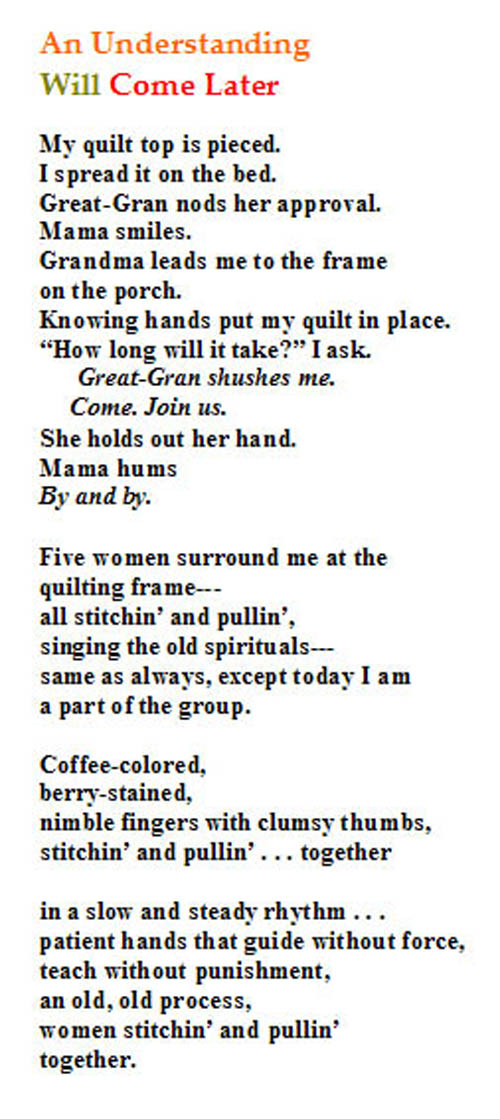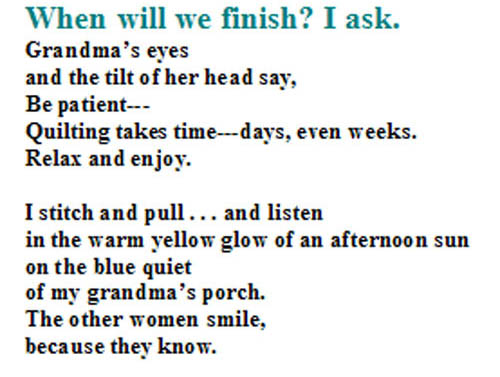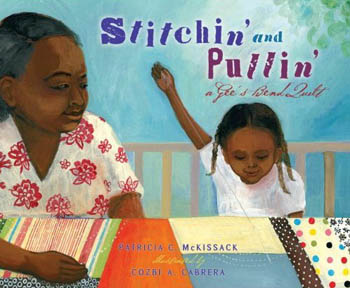Stitchin’ and Pullin’ with McKissack and Cabrera
 November 17th, 2008 by jules
November 17th, 2008 by jules


 That is one of the entries from Patricia C. McKissack’s latest picture book title, Stitchin’ and Pullin’: A Gee’s Bend Quilt (Random House, October ’08), illustrated by Cozbi A. Cabrera. What a beautiful book this is, McKissack having been inspired to share the story of the famous quilters of Gee’s Bend in Alabama, whose quilts have been exhibited across the country since 2002. Part of McKissack’s research involved a trip to Gee’s Bend, where she spent some time watching the quilters and then learning to do a bit of it herself.
That is one of the entries from Patricia C. McKissack’s latest picture book title, Stitchin’ and Pullin’: A Gee’s Bend Quilt (Random House, October ’08), illustrated by Cozbi A. Cabrera. What a beautiful book this is, McKissack having been inspired to share the story of the famous quilters of Gee’s Bend in Alabama, whose quilts have been exhibited across the country since 2002. Part of McKissack’s research involved a trip to Gee’s Bend, where she spent some time watching the quilters and then learning to do a bit of it herself.
These are a series of what the publisher calls “lyrical vignettes,” in which McKissack takes a young child, named Baby Girl, and shows us the quilts through her perspective and her training to make her own first quilt (in “Where to Start?”, her mama tells her, “Look for the heart . . . When you find the heart, your work will leap to life . . . strong, beautiful, and independent”). Before this, Baby Girl plays beneath the quilting frame and the “Nine Patch” quilt her great-great-grandmother and her sisters made “when Great-Gran was herself Baby Girl.” Her mama, grandma, great-gran, and other “warm brown faces . . . sewed, talked, sang, and laughed above my tented playground.” As Baby Girl herself learns to quilt, McKissack uses her fabric choices and experiences to weave together the stories of her family’s past and the struggles of the black community in their isolated town over the years. Or, as McKissack writes in her Author’s Note:
It didn’t take long for me to realize that a quilt is more than fabric and thread. A work shirt, an apron, a suit, or a dress becomes a record of a marriage, a birth, a baptism, an illness, a new house, a special event. Or the fabric might be selected because it’s a historical reminder, the memory of going to vote for the first time at the age of fifty, a hurricane, the closing of the ferry to stop blacks from voting, or a visit by a prominent civil rights leader. These diary quilts are filled with the makers’ personal experiences.
Indeed, Kirkus has written that the book is “an outstanding way to introduce aspects of African-American history and explore the power of community.” Cabrera’s paintings are warm and textured and glow from the pages (don’t miss the “Progress” and “Colors” spreads, in particular).
A stirring anthology, which honors the lives of the women of Gee’s Bend with vibrant art from Cabrera and poetry as only Patricia McKissack can render it. Highly recommended.
Illustration from STITCHIN’ AND PULLIN’: A GEE’S BEND QUILT by Patricia C. McKissack. Illustrations © 2008 by Cozbi A. Cabrera. Published by Random House, New York. All rights reserved.

What a precious art book! This is one of those destined to be a gift for quilters, not necessarily kids. I don’t know any quilters who would let anyone that young work on their frames, but maybe Gee’s Bend is different; they certainly produce quilts that are different.
I’m not sure I agree with Kirkus, though; I’m not sure this is “aspects of African American history,” I think it’s more about quilting history and country community.
And it’s about generations passing what they know to those coming up–and the joy of discovery and creation–and all of the things that you mention and that Kirkus found–makes it a great book, no?
This looks wonderful. Thanks for the spotlight!
TadMack, what Kirkus means is that McKissack weaves in some poems about pivotal moments in African-American history — Jimmie Lee Jackson from Marion getting shot, because he wanted to vote; “the hope Dr. Martin Luther King brought to the Bend,” having spoken at Pleasant Grove Baptist Church; the shutting down of the ferry so that people from Gee’s Bend crossing the river to Camden, Alabama, couldn’t register to vote; desegregation; etc.
And, yeah, it will likely appeal more to adult quilt lovers and quilters. But I would argue that it’s one of those good titles for older readers, even teens (who will let you show a picture book to them).
A fair amount of it is about the poor tenant community that the Bend is (was?), too.
And, yes, evidently they invite young girls to quilt at an early age. “Quilting has always been a bonding factor in their female relationships — mother to daughter, aunt to niece, sister to sister, grandmother to granddaughter, friend to friend,” McKissack writes in the Author’s Note. “One of their rites of passage is a child’s first quilt, since it’s the passing of the craft from one generation to another.”
Hi, Janet and Jama. Yes, it’s a lovely book.
I will definitely have to look for this book. I teach a series of lessons on quilting and it’s applications to math. I keep hoping that just one student a year will pick up this idea and take it into the classroom.
My fifth grade students made a quilt each year as the culminating event for our colonial America unit. It was fun, but a lot of work. And their sewing skills? Absolutely atrocious! However, they enjoyed learning (both boys and girls) and spent every free minute perfecting their squares.
P.S. – Thanks for the great review!
Lovely post. Can’t wait to see the book.
The two illustrations you selected are just gorgeous. I’ll have to find this one. Thanks,
Okay, those illustrations are grand but I must give a shout-out to the text, too.
No one in my family — NO one — has ever quilted, to my knowledge. But the portion of the text which you’ve captured above perfectly evokes the experience of being a little kid and trying to figure out (and adapt to) the mysteries of spending time with adults.
Thanks as always for the intros to wonderful new artists and writers. (Sure, it’s kinda 7-Imp’s reason for being — but so nice to know that y’all are so reliably good at it, too!)
Tricia, what a great project (for both your current students and former ones)!
JES, YES! When I was little and I was shushed out of a room of adults so that they could be adults, I used to wonder and wonder what they could POSSIBLY be talking about. I remember assuming it must be so grand and mysterious, and then I remember feeling disappointed when I found out it wasn’t. During my moments of low self-confidence, I still sometimes feel as if the rest of the adults in the room have some secret that amounts to nothing less than an epiphany that they’re just not sharing with me.
Hi, everyone else. Yes, don’t Cozbi’s illustrations just brighten your day? And it just doesn’t get any better than McKissack.
Jules, yeah… As for me, I formulated a theory when I was a boy — a theory never disproved, btw — that women have some innate ability to know at all times just what guys are thinking. I was and remain slightly nervous around groups of women, especially laughing women, for that very reason.
Now you’ve got me thinking I should have been worried about adults in general. Great. Thanks. 🙂
Happy to help, John.
A friend of mine once told me I could make Worry Consultant into a career. Maybe he was right, seeing as how I just added to your overall paranoia and anxiety. HOO-AH!
I work nights and weekends, too.
I can say that I’m at least one woman who doesn’t even pretend to know what guys are thinking. If I’m laughing in a room, it’s probably because I just remembered something that, say, Homer Simpson once said.
Beautiful post. I’m a quilter and our second graders quilt a nine patch lap quilt every year here – by hand though, not on a frame. I’ll have to look for this book.